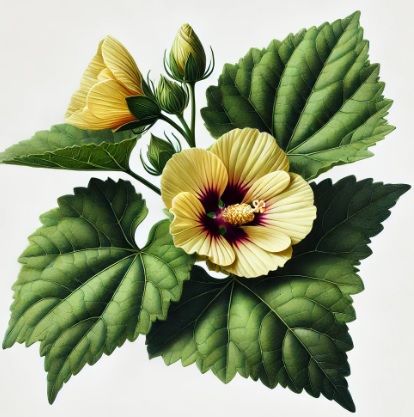Abelmosk, (Hibiscus abelmoschus) is a plant species appreciated for its aromatic seeds and medicinal properties. It is cultivated for both its ornamental value and its utility in traditional medicine. The plant is known for its striking flowers and its ability to grow in various climates.
Botanical Classification:
Family: Malvaceae
Genus: Hibiscus
Species: H. abelmoschus
Common Names: Musk Mallow, Abelmosk
Plant Characteristics:
Size: Hibiscus abelmoschus typically grows to a height of 1.5 to 2.5 meters (5 to 8 feet) and has a bushy, upright growth habit.
Leaves: The leaves are large, ovate, and lobed, with a dark green color. They are often rough-textured and have a serrated edge.
Flowers: The flowers are large and showy, often with colors ranging from yellow to pale orange. They can be up to 10 cm (4 inches) in diameter and feature a prominent central column of stamens. The flowering period is relatively long, providing continuous color in the garden.
Fruit: The plant produces a distinctive fruit capsule that is covered in fine, hair-like structures. The capsule contains aromatic seeds that are used in traditional medicine and as a spice.
Chemical Composition and Structure:
Hibiscus abelmoschus contains several beneficial compounds:
Essential Oils: The seeds contain essential oils that contribute a musky fragrance, often used in perfumes and traditional medicine.
Flavonoids: Similar to other Hibiscus species, it may contain flavonoids such as quercetin and kaempferol, known for their antioxidant and anti-inflammatory properties.
Tannins: Present in the leaves and seeds, contributing to astringent and antimicrobial effects.
Polysaccharides: Found in the mucilage, providing hydrating and soothing effects.
Uses and Benefits:
Ornamental: Hibiscus abelmoschus is cultivated for its attractive flowers and lush foliage. It adds visual interest and color to gardens and landscaping.
Medicinal: The seeds and extracts are used in traditional medicine for their purported benefits, including digestive aid and antimicrobial properties. They are often used in herbal remedies and as a spice in some culinary traditions.
Aromatic: The seeds are valued for their musky fragrance and are used in the perfume industry and as flavoring agents.
Applications:
Gardening: Ideal for garden beds and borders, Hibiscus abelmoschus can be used to create a vibrant and colorful display. It also serves as a focal point due to its striking flowers.
Traditional Medicine: The seeds and extracts are used in various traditional medicinal practices, including treatments for digestive issues and as antimicrobial agents.
Perfume Industry: The essential oils extracted from the seeds are used in perfumery for their distinctive musky scent.
Culinary: In some cultures, the seeds are used as a spice to add flavor to dishes.
Environmental and Safety Considerations:
Environmental Impact: Hibiscus abelmoschus is adaptable to various climates and soil types. It is a low-maintenance plant that can thrive in a range of environments.
Safety: Generally considered safe for cultivation and use. The plant's seeds and extracts are used in traditional medicine and the perfume industry without significant safety concerns. As with all plants, handling should be done with care to avoid potential allergic reactions.
INCI:
Fragrance. It plays a very important role in the formulation of cosmetic products as it provides the possibility of enhancing, masking or adding fragrance to the final product, increasing its marketability. It is able to create a perceptible pleasant odour, masking a bad smell. The consumer always expects to find a pleasant or distinctive scent in a cosmetic product.
Skin conditioning agent. It is the mainstay of topical skin treatment as it has the function of restoring, increasing or improving skin tolerance to external factors, including melanocyte tolerance. The most important function of the conditioning agent is to prevent skin dehydration, but the subject is rather complex and involves emollients and humectants that can be added in the formulation.
Synonyms:
CAS: 84455-19-6 EC number 282-891-8
![]() Abelmosk
Abelmosk 

